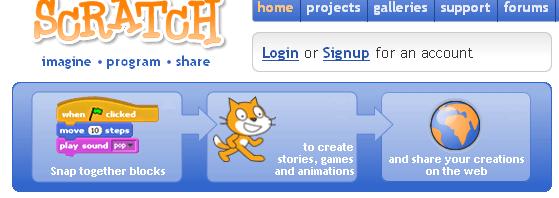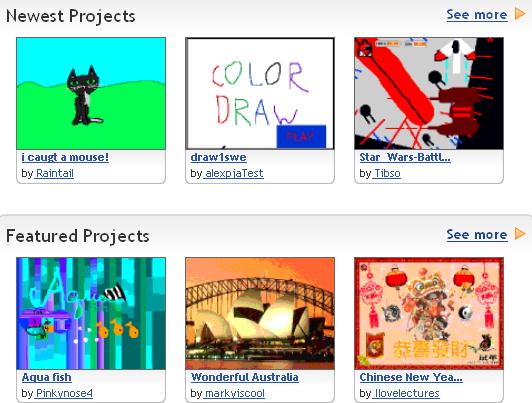 Update: July 30, 2014 Scratch Junior (scratchjr.org) was just released for the iPad today, and it’s FREE. Thx @360Kid for sharing that news!
Update: July 30, 2014 Scratch Junior (scratchjr.org) was just released for the iPad today, and it’s FREE. Thx @360Kid for sharing that news!
Original Post June 13, 2011: I get far too geeky and jargon-ish when it comes to enthusiasm over kids’ science, technology, engineering, and math innovations, (STEM) in hopes of engaging and retaining girls in the field, so I’ll cap the assumptions and start from scratch when speaking about SCRATCH.
Based upon research from National Science Foundation and hubbed at MIT Media Lab, this freebie fun fest for kids 8 and up enables programming basics in a language that’s kid-friendly without complex coding gobbledygook.
Kids can fool around with sound, stories and artistic expression that also bring in important mathematical, reasoning, and computational, collaborative play. It’s the ‘learn without feeling like you’re learning’ hook, a key part of our Shaping Youth strategy of 21st century child-led discovery instead of preach-n-teach drill-n-kill absorption.
I’m convinced it’s part of why our own hands-on demos and counter-marketing works so well…we seed the concept, kids take it and run with it to create their own interpretation and conclusion. Essentially, that’s scratch in a whisker twitch.
Using a mouse, “Scratch replaces complex computer codes with building blocks, Economist.com wrote. “…By dragging blocks on to a desktop area and stacking them on top of one another, a person with no programming skills can, with a few minutes practice, create a dancing cat that changes colour and meows…” Take a peek, the end result is very cool.
Kids jump right in before they’re pre-conditioned to be intimidated by “what they don’t know” in tech, and instead get their hands-on, experiential show-n-tell sharing, while also being able to see their work ‘up in lights’ so to speak, posted for any and all to comment upon.
Even the Scratch site itself takes a minimalist, YOU TELL ‘EM approach to kids’ empowerment by prompting kids to give their own tours and describe ‘what it is and what it does’ firsthand:
“Describe the Scratch Community to someone visiting for the first time.”
Results? A gallery of creations ranging from kid-created tutorials to children showcasing their own animation, games and digital storytelling without all the falderal of how-to hesitations and user manuals. (plus the “epic slide” phase of self-doubt that seems to permeate once kids hit preteen years)
Pretty cool when all you need is the ability to read and some basic familiarity with building blocks and the power of play…On a deeper level, it has the potential to create a ‘gateway’ effect to start asking “How stuff works” by diving beneath the surface and understanding technology, rather than just using it.
I love how Scratch uses familiar ‘adult’ tasks to reach and teach using real world examples too…Like the challenge of customizing the Scratch logo for holidays just like Google changes their own logo’s look. (now there’s kids’ versions of Doodle4Google with prizes to pay it forward on a grand scale)
It’s a great way for kids to be able to discover new media forms, experiment with their own moving art, sound, designs and learn to share peer to peer, while learning about programming, branding, conceptualization, collaboration in an informal play style of STEM skills exploration. Slick hmn?
MIT has always been home to tons of cool media projects (like this I/O art brush I wrote about and their edu-learning camp for grades 7-12 called SPLASH! that lets kids get their feet wet with any type of learning they want to dip their toes into. Shallow end, or deep dive, it doesn’t matter…the kids are in charge and they have freedom to ‘splash around’ to find their passions and explore new areas they may never have been exposed to. (a 13 yr. old middle school girl shares her experience in a story to come)
Also upcoming in positive picks is my favorite newcomer to the learning meets gaming arena called Vanished…
…An MIT two month pilot project to get middle schoolers jazzed about science and turn textbook boredom into eco-mystery fun solving puzzles about the environment in ‘save the planet’ sci-fi mode. (yes, there’s even a narrative involving alien invasions and hackers)
Stay tuned for an interview with 11-year old Rylan who shows her prowess about Vanished and perhaps even provides the upcoming attendees of the ISTE 2011 conference June 26-29 2011 some food for thought in terms of exciting ways to engage girls in science without being cheesy, overly geek chic and sustainable to step out into sequel format…Love the concepts. Fresh. Innovative. And unequivocally fun.
I think part of MIT Media Lab’s ongoing success comes from asking the right open-ended innovation questions, using ‘building blocks’ of understanding to layer the learning, and making problem-solving more like a game. As the ISTE 2011 folks quoted Charles Kettering in this post about Recruitment and Retention of Girls in STEM:
“A problem well stated is a problem half solved.”
These folks at MIT know how to ask the right questions…
What are yours? And what will you create from Scratch?
p.s. I’ve had this post percolating so long, this MIT Media Lab digital darling has shifted its own tagline from “Animate. Create. Share.” to “Imagine. Program. Share.”
The ever so slight nuance tips me into thinking they’re veering toward ‘think bigger’ tool sets of STEM to bridge into more advanced tinkering…(beyond ‘snap together’ blocks perhaps to more ‘free form’ creation once the basic concepts are formed?) Are we looking at:
The Lincoln Logs of the 21st century?
For more about the Scratch move to the cloud see their ongoing blog.For those who wonder what does “being in the cloud” even mean (and why should I even remotely care) ask your kids. They’ll be creating some cool digital ditties there…
And for those emphatic about getting kids outdoors to stare at nature’s cloud formations, unplugged and off-line (raises two hands)…remember, that kind of STEM exploration of imagination “in the clouds” can never be replicated, but can always be shared. (preferably looking skyward, flat on your back in a field of green on a lazy summer day
Related Resources: Digital Tech/STEM That Stims:
A 5-Year Old Game Designer? Sara Grimes Reports on GameLab
4 Tools For Teaching Kids to Code (RWW)
Kodu Game Lab: Microsoft Fuse Labs for Kids
MS Launches Kodu Game Lab Competition for Kids
Google’s Summer of Code (Open Source/Teens)
Related Resources on Shaping Youth/STEM Specific
Wise Women & Alice 3.0: Geek Chic For Girls (pt.1)
BrainCake: Teen Girls Talk Tech & Worldchanging (pt.2)
DigiGirlz: Teen Girls Build Community Online & Off (pt.3)
Shaping Youth Sponsors She’s Geeky: WIT & Wisdom Flourish
Project Raceway: ShopGirls Build STEM Eco-Marathon Car
She’s Geeky: Techno Leaders Converge
She’s Geeky:Vlogging with Ryanne Hodson at She’s Geeky
Media Moms, Engineers, Purple Tornadoes At She’s Geeky
She’s Geeky and Proud of It (My first Shaping Youth geekery)
Misguided Media: Space station takes a backseat to Britney?
Kids Online UNconference: Kaliya Hamlin, Joi Podgorny
Shaping Youth Interviews Girl Mogul Founder/Geek Chic
Here are a few sample ‘tutorials’ to show you how the ‘blocks’ of Scratch code work. These are simple basics (vs storytelling and sophisticated movies/animation) but you can easily see how much fulfillment kids can have seeing their work come to life with free, easy, ‘building blocks’ of STEM.












a friend of mine told me about this Scratch thing 2 days ago….and now I’m reading all about it in your blog! it seems like a great tool for child’s development!
Thanks!
This looks incredible. I can’t wait to play (I mean, let my kids play)!